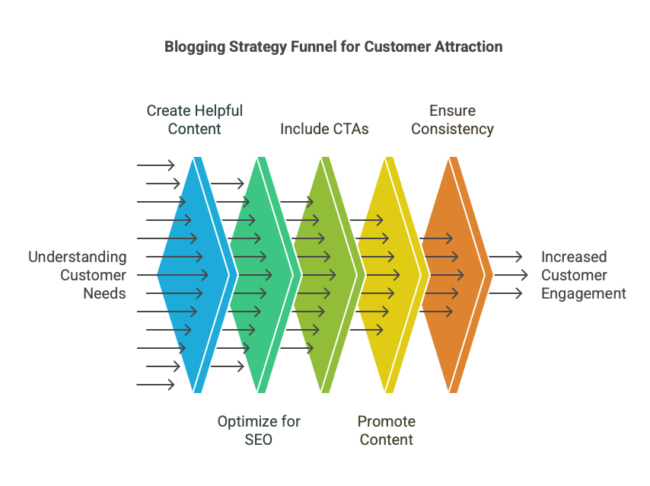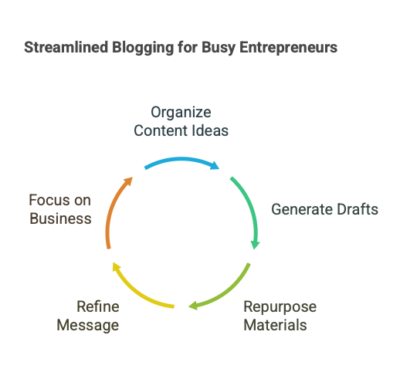
Running a small business in 2025 is a balancing act. You’re managing operations, serving existing clients, handling finances – and somehow, you also need to consistently attract new customers to ensure growth. With traditional advertising often demanding hefty budgets, how can small and medium-sized enterprises (SMEs) effectively reach their target audience and stand out from the competition?
The answer might be simpler, more sustainable, and more powerful than you think: **Blogging.**
Far from being just an online diary, a strategic business blog is a potent marketing tool. It allows you to connect with potential customers, build trust, showcase your expertise, and drive qualified leads – often at a fraction of the cost of paid advertising. This guide breaks down exactly *how* your small business can leverage blogging to attract more customers this year.
Why Blogging is a Game-Changer for Small Businesses in 2025
 If you’re wondering whether the effort of blogging is worth it for your SME, consider these significant benefits:
If you’re wondering whether the effort of blogging is worth it for your SME, consider these significant benefits:
- Attract Organic Traffic via SEO: When potential customers have questions or problems related to your industry, where do they go first? Google. By creating blog posts that answer these questions using relevant keywords, you increase your chances of appearing in search results. This brings people who are *actively looking for solutions* directly to your website – highly valuable, targeted traffic!
- Build Trust and Credibility: Consistently sharing helpful, informative content positions your business as a knowledgeable authority in your field. You’re not just selling; you’re helping. This builds trust, making potential customers more comfortable choosing you when they’re ready to buy.
- Generate Qualified Leads: Offer valuable resources within your blog posts – like checklists, e-books, templates, or webinar invites – in exchange for an email address. These “lead magnets” help you capture contact information from interested prospects whom you can then nurture through email marketing.
- Connect with Your Audience Authentically: Blogging allows you to share your company’s personality, values, and stories. It helps humanize your brand, creating a stronger connection with potential customers than impersonal ads ever could.
- Differentiate from Competitors: What makes your business unique? Use your blog to highlight your specific expertise, your unique approach, customer success stories, or company culture. It’s a fantastic platform to show why you’re different and better.
- Fuel Your Social Media Presence: Struggling for social media content? Your blog posts provide a steady stream of valuable material to share, driving engagement and directing traffic back to your website.
- Create a Long-Term Asset: Unlike an ad campaign that stops when the budget runs out, a well-written blog post can attract traffic and generate leads for months, or even years, providing ongoing ROI.
Strategic Blogging Steps for Customer Attraction
Ready to start? Here’s how to approach blogging strategically to attract customers:

- Deeply Understand Your Ideal Customer & Their Problems: Who are you trying to reach? Go beyond basic demographics. What are their biggest challenges related to your industry? What specific questions do they type into Google *before* they even know your type of solution exists? Brainstorm these pain points and questions.
- Focus on Helpful, Problem-Solving Content: Your blog shouldn’t be just a sales pitch. Prioritize creating content that genuinely helps your audience. Think:
- How-to guides
- Checklists and tips
- Answers to frequently asked questions (FAQs)
- Explanations of industry concepts in simple terms
- Troubleshooting advice
- Case studies showing problems solved
Use basic keyword research tools (even Google’s own search suggestions and “People Also Ask” section) to find the exact phrases your customers are using.
- Optimize for Local SEO (If Applicable): If your business serves a specific geographic area (like Gdańsk, for example), weave local elements into your strategy. Use location-specific keywords (e.g., “best accountant in Gdańsk”), write about local industry news or events, and ensure your Google Business Profile is optimized and linked to your site.
- Include Clear Calls-to-Action (CTAs): Don’t leave readers hanging! Tell them what you want them to do next. Your CTA doesn’t always have to be “Buy Now.” Consider relevant next steps like:
- “Download our free [Resource Name] guide”
- “Schedule a no-obligation consultation”
- “Learn more about our [Specific Service/Product]”
- “Contact us with your questions”
- “Subscribe for more tips like this”
- Promote Your Blog Content: Publishing is only half the battle. Share your new posts on your business’s social media profiles (LinkedIn, Facebook, etc.), include links in your email newsletters, tell relevant clients about new posts, and consider outreach if appropriate.
- Be Consistent (Focus on Quality & Realism): You don’t need to publish daily. Choose a realistic schedule – weekly, bi-weekly, or even monthly – that you can stick to consistently. High-quality, helpful content published regularly is far better than frequent, low-value posts. Consistency is where efficiency tools become invaluable.
- Make Conversion Easy: Ensure your website design makes it simple for interested blog readers to take the next step – easily find your contact information, navigate to service or product pages, or sign up for your lead magnets.
Making Blogging Achievable for Busy Small Businesses
 Reading through these steps, you might be thinking, “This sounds great, but I run a business! Who has the extra hours to consistently research, write, optimize, and promote blog posts?” This is a valid concern for many SMEs, where time is often the scarcest resource.
Reading through these steps, you might be thinking, “This sounds great, but I run a business! Who has the extra hours to consistently research, write, optimize, and promote blog posts?” This is a valid concern for many SMEs, where time is often the scarcest resource.
The good news is that you don’t have to do it all manually, and technology can bridge the gap. Tools designed to streamline content creation, like BlogCopilot, can make implementing a consistent blogging strategy feasible, even for busy teams or solo entrepreneurs. By assisting with tasks like organizing content ideas, generating initial drafts based on your expertise, or even repurposing existing materials into blog format, such tools free up your valuable time. They handle some of the heavy lifting, allowing you to focus on refining the message, adding your unique insights, and running your business, while still reaping the significant customer attraction benefits of blogging.
Conclusion: Start Attracting Customers Through Your Blog
In 2025, blogging remains one of the most effective and sustainable ways for small businesses to attract customers, build trust, and grow. It allows you to connect with your audience on their terms, providing value long before they make a purchase decision.
Don’t be intimidated! Start small by identifying your customers’ key questions and commit to answering them consistently through helpful blog content. Focus on providing genuine value, promote your posts, and make it easy for readers to take the next step.
Ready to make strategic blogging a manageable and powerful part of your small business marketing? Explore how BlogCopilot can help you create quality content more efficiently today!
